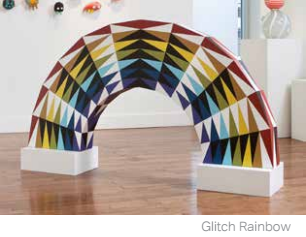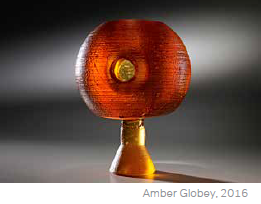Artist Lectures 2017 #1 Tim Belliveau & Angela Thwaites
- Daniel Rollitt

- Feb 1, 2017
- 5 min read
Whilst studying for a BA Hons in Glass and Ceramics at the University of Sunderland, we have regular lectures from a variety of artists working in different disciplines.
This week we had one of the co-founders of Bee Kingdom Glass, Tim Belliveau, whom set up studio straight out of Alberta college with two of his friends. It was inspiring to hear how they managed to build a studio from scratch, based upon what information they could get from library books and tutors, and any materials they could get hold of, setting up in a garage on land that one of their family owned and only paying rent. As practical as I am, I'm not sure I would have had the confidence to do the same at such a young age. They all started producing colourful blown work based upon Japanese cute-culture which they then 'wadded' together to cleverly create one-off totem-pole-like works. They were also involved in Pilchuck's Auction programme in 2008 whereby they and 30 volunteers produced work to sell. Alongside this work they regularly applied for four or five grants a year, design competitions, and produced work for galleries, as well as taking commissions. They also travelled to Berlin Glas e.V. in 2012 and helped establish a studio there as there was not easy access to glass hot shops there at that time. Some of the other things they took part in was producing blown glass micro-organisms for Calgary Watershed Trust appreciating the beauty in the nasty things that are filtered out of people's water. These reminded me of Luke Jerram's work on Glass Microbiology.
Tim took the initiative to explore other avenues outside of Bee Kingdom and started to get more involved / inspired in the increasing digital side of things. He studied for a BFA Research in Concodia Montreal as part of the Fiber program and started by using Blender (a free rendering program) to produce 3D renders that he could show to clients before producing work, thereby making any changes needed before producing something in hot glass, saving time, money and materials. Having the knowledge and skills in hot glass obviously helped as renders look identical to the glass-made objects. When he rendered one of his designs, a rainbow, there was a glitch in the program, which he has coined as 'glitchcraft'. Instead of rendering coloured bands, it created alternating triangles of colour and white. Taking inspiration from this he then produced the work as it appeared and found it had optical illusions in the physical world. He then explored this further by creating virtual galleries consisting of some real works and virtual works. Some of his renders were impressively realistic and could well be used to show curatorial skills for those interested in that sort of career.
In his talk he referred to how there has always been technology or equipment used to enhance working techniques such as the pantograph being a precursor to digital arms, and how the Jacquard loom was the prototype for the computer, linking to his studies in the Fiber program. He has also researched how CGI technology was implemented in movies and games.
He stated that digital technology is transforming identities and questioned who is the maker, and what response there is from the community.
He also made references to the advanced techniques of casting employed by the Romans in 1 A.D. producing 'Ennion' branded cups showing no visible seams, and how they were able to produce such objects without the use of the advanced technologies and the material understanding we have today.
Tim has used blender to design mould designs for blowing vessels in hot glass using selective laser sintering (SLS) in bronze. He is currently involved in research in the Netherlands exploring this further, to produce ceramic moulds. As a Glass and Ceramic student I find this use of two often opposing mediums really interesting and new. He brought in a few samples and demonstrated this by blowing an attractive faceted diamond shaped vase that he then added Romanesque elements to it, transforming it into a small jug with a handle and foot ring, mixing contemporary technology and process, with historic design using his hot glass skills. The foot ring was created from some of his other experiments made using ceramic stamps and rollers that he used to give hot glass a design and texture, made from both slip cast and pressed clay. He had been investigating the methods used in the past with the help of archaeologists David Hill & Mark Taylor in southern England.
I found Tim's talk fitted in very nicely with the next speaker, Angela Thwaites, currently studying her PHD at the University of Sunderland. I have had the pleasure of speaking to Angela on a number of occasions and she is very helpful and pleasant with years of experience in casting glass.
Her current work explores 'making the unmakeable in glass' and she uses 3D printing to produce small cast objects, some of which are assembled from multiple printed parts and contain voids within them. This last comment will perhaps come of no surprise considering she studied at the Libensky studio in Czechoslovakia when she was a young student in what was then communist Prague at the Academy of Applied Arts. She described the experience as somewhat daunting with a language barrier between herself and the Czechs and Slovaks, struggling with the basics like going food shopping. The Libensky's are well known master Czech casters who explored form, light, and mass of material, often incorporating voids into their work. This linked back to Angela's own studies at University in Farnham where she experimented with porcelain clay and glass, materials that share the qualities of translucence and colour.
She talked about her varied career since leaving university, teaching partly, as well as occupying a number of small studios. She explained how she controlled light through working the surface of cast objects, either through working the wax or through cold-working afterwards.
She was part of New London Glass Group and exhibited works in places such as the crypt in St Pancras. In 2000 she experimented with refractory mould casting whilst studying at the RCA and tried to master model and mould making, looking at the history of kiln-formed glass and wrote a book in 2011.
She explained how experimenting with PLA and lost wax, this has allowed her to work on a smaller scale, developing ideas and shapes much quicker, referring to M.C. Esher by creating worlds within worlds. TinkerCAD is one of the programs she used to gain an easier access to 3D printing. She explained how she still finds the need/want to work with the material on a more intimate level and therefore still sometimes engraves casts that have been 3D printed. She has experimented with other materials such as burning out wood to then cast glass inside. Working on such a reduced scale has meant that she has used an endoscope to photograph her work and view the details of the casting process close up like macro photography.
Angela has deliberately left some elements of the casting process visible such as supports to prop up top-heavy structures. Vent tube (as positives) are also left. When questioned about this, Angela responded that because of her casting experience, it is obvious to her where these need placing and in leaving them as part of her work she is wanting viewers to question her intent. This is part of a dialogue between the artist and the audience, one where unless the artist is present, they may never know what someone thinks of a work and asking someone to question something bringing about a deeper observation and understanding of a work.
I found both these talks interesting, more-so because they relate to my thinking behind a current project in which I want to experiment with casting glass, making use of 3D printing technology and also exploiting voids within my work to produce the unclear.



































Comments